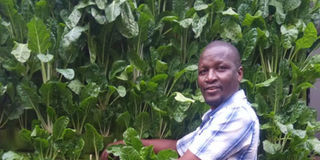How to make a vertical sack garden

Afarmer tends to his spinach growing in sacks. Farmbiz photo
For many urban and slums dwellers, space is limited, while for those living in areas with insufficient rains, the same is true of water.
For all these growers, vertical sack gardening technology is emerging as a way to grow a large supply of vegetables despite the constraints.
The garden is most suitable for growing vegetables such as kales and spinach, corianders, onions, tomatoes, okra and eggplant.
Normally when the green leafy vegetables are ready for harvest they can be harvested two to three times a week and deliver strong nutritional value, containing vitamins A, C and K that are particularly good for growing children.
Here is a guide to making a vertical sack garden:
Tools
Hoe -to dig the soil that will be mixed with other components for constructing the garden.
Fork hoe -to dig the soil in hard ground areas. Spade -used in collection and mixing the soil components.
Knife - to cut the top part of the tin completely.
Tin punch- to punch holes on the tins surfaces and the bottom.
Wheelbarrow - to measure and transport the various soil parts to the recommended ratio.
Equipment, purpose
Perforated tins, 50 kilogramme sacks, gravel, clay soil, sand soil, manure, seeds and water.
Perforated tins - to pass water through to the soil component, hold the gravel in the sack, filters dirty water, bottom tins have few holes and no holes on the bottom, second bottom tin have more holes and third tin has more holes than the rest.
Sacks- to hold the soil and acts as a planting base.
Gravel- to water garden through it and filter dirty water and to divert the flow of waterside ways.
Clay soil -to collect the topsoil for better crop development. It is the main soil part of the garden.
Sand soil -to create air spaces.
Manure- to provide nutrient to the soil for good plants growth. It should be well rotten manure.
Garden construction
Mix the soils with the manure well. Put two spades in a sack and level them.
Place the bottom tin perforated at the sides filled with gravel, but not perforated at the bottom on the soil.
Fill the soil at the sides to the level of the tin and place the other tin on it.
Fill the soil again at the sides to the level of the second tin.
Repeat the same process till the last tin.
Finally perforate the sack in readiness to planting: these perforations should be at different heights and spaced all the way around the sack: they are where you will plant your seedlings to grow in the garden.
Introduce water
After the garden is constructed, water is poured into the tin at the centre of the bag and drains through the stones down through to the end of the bag of soil irrigating all the plants throughout the depth of the bag.
The garden should be placed where there is no direct sunlight, wind and interference for maximum yields.
Sowing can be done on top part of the garden, which can be used as a seedbed. When the seedlings emerge, transplant them to the perforations in the sides of the garden.
After transplanting, watering is done in the morning and evening, with five litres of water at each watering. You can also use waste water from the kitchen, water stands, taps, and kiosks spillage water to water the garden.




